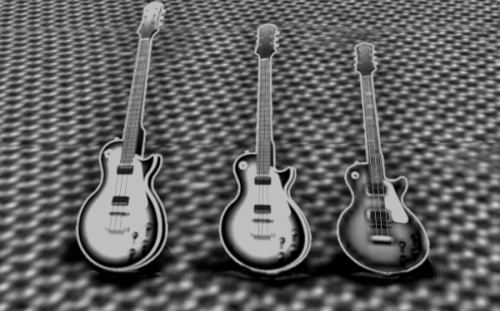BY LETTER
Nanoinstruments, Nanomusic
 Image from Steve Bowers |
In 2266 CE (297 AT), riding a wave of hype about recent advances in nanoscale molecular assembly, the European multimedia entertainment corporation FiveSense released a line of nanoscale musical instruments, including guitars, harps, pianos, and others, which they dubbed "nanoinstruments", as well as the first in a series of albums of songs performed using these instruments, which they called "nanomusic". As the music-appreciating sophonts of the day could not detect the tiny vibrations made by the nanoinstruments, all such sound required detection by nanoscale microphones coupled with heavy digital processing to change the pitch and volume to something listeners could actually hear.
The nanoinstruments differed significantly in structure from their normal-sized counterparts to compensate for their tiny size. The strings of the nanoguitar, for instance, were made of carbyne - single carbon atoms with alternating single and triple bonds. The instruments were played with nanoscale manipulators that required computers for precision control. FiveSense boasted that the sounds produced by these structures were unprecedented. With guidance from corporate superturings, the marketing campaign was a success, with nanomusic and nanoinstruments becoming especially popular in the California Republic and Antarctic Free States.
However, as with other entertainment trends, it was not to last. Voices of criticism - who were themselves accused by nanomusic's supporters of being shills for competing corporations, which is possible - noted that nobody was actually hearing the nanoinstruments, but rather digitally generated sounds that merely correlated with the nanoscale sound waves. Their argument was bolstered when it was later proved in a series of double-blind studies that humans and the other music-enjoying sophonts of the time could not possibly detect any difference between "nanomusic" created with nanoinstruments and that generated purely by the processing software. The fad's end, insofar as one can be clearly defined, is generally considered to be in 2271 CE when a FiveSense-sponsored side-by-side competitive performance at California's prestigious Marin Arcology Concert Hall, in which the side that actually contained real nanoinstruments was kept hidden, famously resulted in the audience voting that the purely digital nanomusic was superior by a large margin.
Though the so-called nanomusic fad died down, other applications of nanotechnology to music had much more staying power. A major example of this was via the use of nanofactured materials such as diamondoid to create normally-sized musical instruments; the properties of such substances resulting in acoustic effects that gave the instruments a unique sound. Saphiroid violins, for instance, were popular in several genres of Martian music during the Solsys Golden Age. To this day instruments made using such materials can be found scattered across the cultures of the Terragen Sphere. While the nanoinstrument fad itself devolved into just another cautionary tale about misguided hype for new technologies, more sensible uses of nanotechnology went on to revolutionize Terragen life.
Appears in Topics
Development Notes
Text by ProxCenBound
Revised from an original by Ernst Stavro Blofeld; updated 6 October 2022
Initially published on 19 February 2002.
Inspired by nanoscale musical instruments, such as this nanoscale guitar developed in 2015.
Revised from an original by Ernst Stavro Blofeld; updated 6 October 2022
Initially published on 19 February 2002.
Inspired by nanoscale musical instruments, such as this nanoscale guitar developed in 2015.






